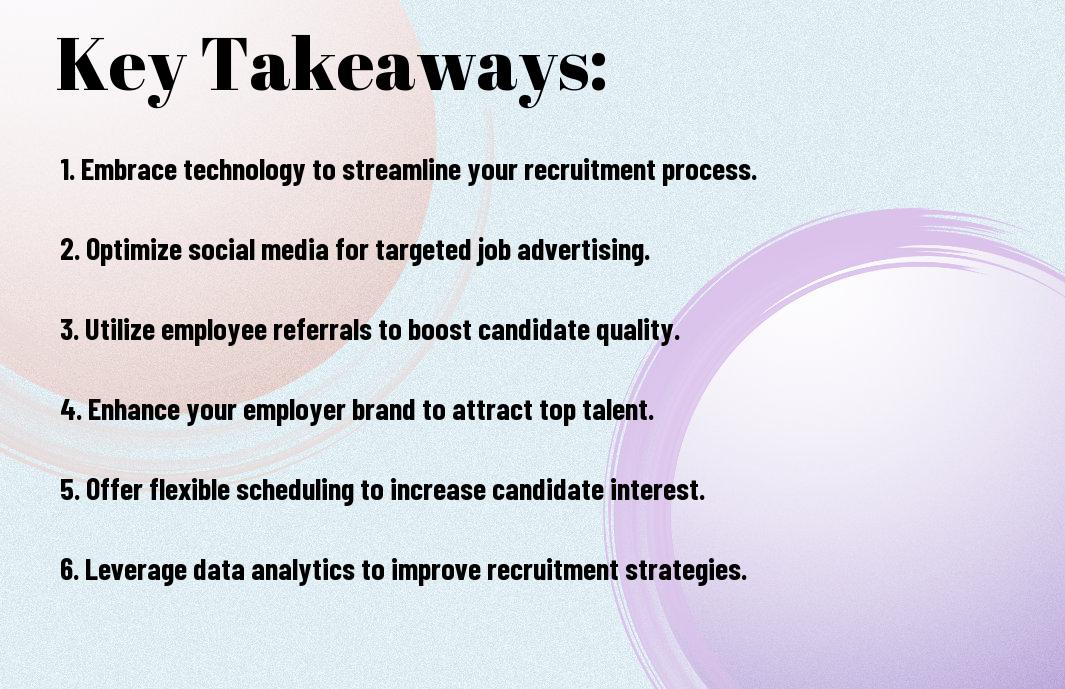Most senior care facilities face overwhelming staffing challenges that can threaten the quality of care you provide. In a competitive market, the pressure to attract and retain qualified staff can feel like a never-ending nightmare. Fortunately, there are effective digital strategies available that can help you streamline your recruitment process and enhance your outreach. This post will explore actionable techniques designed specifically to tackle the unique challenges you encounter in senior care recruitment, ensuring your facility remains staffed with the best talent possible.
Key Takeaways:
- Targeted Advertising: Utilize digital marketing strategies to reach the right candidates through tailored ads on social media and job boards.
- Engaging Job Descriptions: Craft compelling job descriptions that reflect your organization’s culture and values to attract top talent.
- Streamlined Application Process: Simplify the application process by using technology that allows for easy navigation and submission for potential applicants.
- Effective Use of Social Media: Leverage platforms like LinkedIn and Facebook to build a community around your organization and foster engagement with prospective employees.
- Data-Driven Recruitment: Implement analytics tools to track recruitment metrics and adapt your strategy based on what works best for attracting candidates.

Understanding the Staffing Crisis in Senior Care
To fully grasp the magnitude of the staffing crisis in senior care, it’s important to recognize the myriad challenges facing the industry today. Aging populations are increasing rapidly, leading to a higher demand for quality senior care services. However, many facilities struggle to keep up with this growing need due to a variety of factors, including inadequate staffing levels, rising turnover rates, and a decreasing pool of qualified candidates. These dynamics present a complicated scenario where providers must swiftly adapt to ensure the safety and well-being of their residents.
To address these challenges effectively, your strategies must cover not only the basic recruitment processes but also the underlying issues that create staffing shortages. Fostering a positive workplace environment, offering competitive compensation packages, and embracing flexible scheduling can significantly enhance your ability to attract and retain talent. As you implement these practices, it’s vital to maintain open lines of communication, allowing your staff to voice concerns and feel valued within your organization.
Current Trends in Senior Care Recruitment
Recruitment in senior care is evolving as organizations realize the necessity of adapting their approaches. Innovative technologies and platforms are emerging to help streamline the hiring process, making it easier for you to connect with potential candidates. Social media is playing an increasingly important role, offering a way to showcase your unique workplace culture and job opportunities directly to job seekers. Additionally, many companies are focusing on cultivating a talent pipeline, which allows you to maintain a steady flow of qualified candidates that can quickly fill positions as they open.
Another trend is the growing emphasis on employee wellness and support systems to tackle high turnover rates. Ensuring your team feels supported through mentorship programs, professional development opportunities, and mental health resources can enhance employee satisfaction, which in turn reduces attrition. By staying updated with these trends and being willing to adapt, you can more effectively address the staffing challenges facing the senior care industry today.
Impact of Staffing Shortages on Quality of Care
Quality of care is directly impacted by staffing shortages, leading to potential risks for your residents. When facilities are understaffed, you may find that caregivers are overwhelmed with their responsibilities, which can result in decreased attention to individual patient needs. This under-provision of care can lead to severe consequences, including medication errors and higher rates of injuries. As care quality suffers, it may also impact your facility’s reputation, making it even more difficult to attract new staff and residents.
Senior residents are notably vulnerable, and insufficient staffing levels can lead to a decline in their overall health and well-being. A lack of personal attention may foster feelings of isolation among residents, ultimately affecting their mental health. Moreover, the strain on your already limited resources can lead to burnout among existing staff, furthering the cyclical nature of this crisis. Thus, addressing staffing shortages is not merely a logistical endeavor; it’s fundamentally about ensuring the quality of care and enhancing the lives of the seniors you serve.
Digital Recruitment Strategies
Some traditional methods of recruitment can be time-consuming and may not yield the desired results. Embracing digital recruitment strategies allows you to engage a broader audience and streamline your hiring process for senior care positions. By incorporating various digital tools and platforms, you can reach prospective candidates more effectively, ensuring that you have access to a diverse pool of talent. This way, you can overcome staffing challenges and build a dedicated team that can elevate the quality of care in your organization.
Leveraging Social Media for Outreach
Across the digital landscape, social media has emerged as a powerful tool for recruitment. By utilizing platforms like Facebook, LinkedIn, and Instagram, you can connect with potential candidates where they spend their time. Posting job openings, sharing employee testimonials, and showcasing the culture of your senior care facility not only attracts skilled professionals but also fosters a sense of community. Engage with your followers by responding to comments and encouraging shares; this can greatly increase your visibility and reach.
Implementing AI-Driven Recruitment Tools
After realizing the potential of digital strategies, you may want to consider implementing AI-driven recruitment tools that enhance your hiring process. These tools can significantly reduce the time spent on screening candidates by quickly analyzing resumes and matching them to your specific requirements. Furthermore, they can help you identify subtle patterns in applicant behavior, allowing you to better understand what types of candidates are the best fit for your organization. By integrating such advanced technology, you can ensure that your recruitment process is both efficient and effective.
Social media is not the only component of modern recruitment strategies; AI-driven tools also play an increasingly important role. With these tools, you can automate routine tasks, such as interview scheduling and initial candidate assessments, freeing up your time to focus on personal interactions and making informed decisions. The ability to rapidly process large amounts of data means you won’t miss out on high-quality candidates who could enrich your senior care team. By embracing these technologies, you empower your recruitment efforts, turning potential staffing nightmares into successful hires.
Enhancing Candidate Experience
Many organizations face challenges in attracting talent in the senior care sector, but prioritizing candidate experience can significantly change the recruitment landscape. When candidates engage with your hiring process, they often form their first impressions of your organization. A seamless and supportive experience not only boosts your recruitment efforts but also reflects your care values and commitment to both clients and employees. This is more than just filling positions; it’s about fostering a sense of connection that can lead to higher retention rates and a more engaged workforce.
Streamlining the Application Process
An effective application process is one that minimizes hurdles and enhances user accessibility. Optimize your online application system to allow candidates to submit applications swiftly, perhaps utilizing modern technology like mobile-friendly interfaces and one-click application options. Ensure that your form asks only for necessary information to avoid overwhelming potential hires. Additionally, consider providing an estimated timeline for the process and keeping candidates updated on their status. When candidates feel informed and supported, they are more likely to engage further.
Building a Strong Employer Brand
Brand awareness plays a significant role in attracting the right candidates to your organization. A strong employer brand communicates your values, culture, and the benefits of working with you, helping potential hires envision themselves in your environment. Highlighting employee testimonials, showcasing clear pathways for career advancement, and demonstrating your commitment to a supportive workplace can significantly enhance your allure as an employer. Your online presence should accurately reflect what you stand for, reinforcing trust and engagement from future employees.
Due to the competitive nature of the senior care field, it’s vital to create a powerful employer brand that positions you as a top choice among job seekers. Focus on conveying your unique offerings, such as comprehensive training programs, a positive work environment, and a dedication to community service. Establishing a distinctive brand image will not only attract skilled candidates but will also create lasting loyalty among your employees. When your brand resonates with the mission-driven professionals in the sector, you can turn your staffing nightmares into success stories. Attention to these aspects directly impacts the quality of candidates you attract, creating a more robust team to provide care and support.
Targeted Marketing Approaches
Now, in the ever-evolving landscape of senior care recruitment, adopting targeted marketing approaches can significantly enhance your ability to attract the right candidates. Traditional methods may no longer suffice; you need to engage more effectively with potential hires where they are. Leveraging digital platforms tailored to your audience not only brings your facilities into the spotlight but also fosters a connection with individuals who may not actively be seeking new opportunities. For insights on effective strategies to navigate challenges within this sector, consider reading more on Navigating the Senior Living Staffing Crisis.
Identifying and Engaging Passive Candidates
Behind every successful hiring strategy is a deep understanding of the talent landscape, and passive candidates are often an overlooked yet abundant resource. These individuals, currently employed but not actively looking for a new position, may possess the skills and experience you need. Engaging them requires a subtle approach, utilizing personalized outreach and creating compelling content that resonates with their values and aspirations. You can foster relationships through social media campaigns, targeted content marketing, and inviting them to virtual events or webinars that highlight your organization’s mission.
Utilizing Data Analytics for Recruitment
Utilizing data analytics for recruitment can dramatically improve your decision-making processes. This approach enables you to draw insights from various recruitment channels, employee surveys, and market trends. By understanding which strategies yield the best results, you can allocate your resources more effectively and tailor your messaging to align with the interests and motivations of potential applicants. Incorporating analytics will help you track candidate behaviors and preferences, allowing you to refine your recruitment tactics continuously.
But while the benefits of data analytics are vast, it’s important to ensure that your data sources are reliable and your analytics are interpreted correctly. If misapplied, data can lead to misguided decisions that could negatively impact your recruitment strategy. Therefore, fostering a culture of data-driven decision-making within your organization is vital—this way, you can make informed choices that not only improve your recruitment efforts but also enhance employee retention and satisfaction.
Training and Retention Strategies
Unlike many organizations that overlook the importance of robust training and retention strategies, you can pave the way for a more stable workforce in your senior care facility. By investing in your employees, you not only enhance job satisfaction but also reduce high turnover rates that often plague the industry. This ensures that your team feels empowered and valued, translating to better care for your residents and a more harmonious work environment.
Onboarding Best Practices
Along with hiring the right talent, implementing effective onboarding best practices is important for setting the tone for new employees. Introducing them to your organization’s mission, values, and expectations from day one fosters a sense of belonging and purpose. Tailored training modules that include hands-on activities and mentorship opportunities will equip new hires with the tools they need to excel in their roles, ultimately increasing their commitment to your organization.
Continuous Education and Career Development
Best of all, when you prioritize continuous education and career development, you’re not just investing in individual employees; you’re enhancing the whole organization’s performance. Offering various training programs, certifications, and workshops allows your staff to expand their skill sets and stay updated on best practices within the senior care industry. This ongoing professional development positions your organization as a leader in quality care while demonstrating that you are committed to your employees’ growth and success.
Strategies such as providing clear career pathways and opportunities for advancement not only improve morale but also encourage employee loyalty. Implementing mentorship programs and peer learning can enrich your team’s knowledge while building a supportive community. Additionally, by regularly evaluating the effectiveness of your training initiatives, you can make necessary adjustments that align with both your employees’ goals and your facility’s vision. The long-term benefits of cultivating a well-trained, satisfied workforce directly lead to enhanced care quality that your residents deserve.
Measuring Recruitment Success
Your approach to measuring the success of your recruitment efforts can significantly influence the overall health of your senior care organization. By analyzing metrics related to your recruiting processes, you can identify strengths and weaknesses. Current challenges and potential solutions to the use of digital strategies in recruitment are often evident through your performance data. This data enables you to make informed decisions and prioritize improvements, ensuring that you attract quality candidates who are a good fit for your environment.
Key Performance Indicators for Recruitment
Recruitment is not just about filling positions; it’s about filling them with the right talent. Key performance indicators (KPIs) such as time-to-fill, cost-per-hire, and applicant quality should be tracked meticulously. By establishing benchmarks for these KPIs, you can highlight areas of success and pinpoint where adjustments may be necessary. Additionally, analyzing source effectiveness helps you to determine which recruitment channels yield the best candidates, allowing you to focus your resources more effectively.
Adapting Strategies Based on Feedback
By collecting and analyzing feedback from new hires and ongoing staff, you can fine-tune your recruitment strategies. Surveys and interviews can reveal what attracted candidates to your open positions and areas for improvement in your hiring processes. Using this feedback proactively can help you tailor your recruitment messages, making them more appealing and true to your organizational culture.
At the same time, it’s crucial to listen to feedback from current staff regarding their experiences during the hiring process. Insights gained can help foster a more effective recruitment journey and further enhance your organization’s reputation. Moreover, maintaining an open dialogue allows you to make real-time adjustments that can establish a more positive experience for future candidates. This kind of responsiveness not only attracts strong talent but also enhances employee morale, paving the way for a more cohesive workforce.

To Wrap Up
With these considerations in mind, you can tackle your senior care recruitment challenges more effectively. By implementing proven digital strategies, such as optimizing your online presence and utilizing targeted recruitment platforms, you can reach and engage the right candidates more efficiently. Understanding your unique staffing needs and adapting your marketing efforts to highlight the advantages of working in your facility not only attracts talent but also fosters a positive brand image that resonates with potential hires.
Your success in overcoming staffing nightmares lies in leveraging technology and strategic outreach. Focus on creating a compelling candidate experience that reflects your organization’s values and mission. By prioritizing strong communication and promoting a supportive work environment, you will not only fill your open positions but also build a dedicated team that enhances the quality of care provided to your residents, thus ensuring the sustainability and growth of your senior care operations.
FAQ
Q: What are the main challenges faced in senior care recruitment?
A: Senior care recruitment presents several challenges such as high turnover rates, a limited pool of qualified candidates, and intense competition among facilities. Additionally, many potential candidates may not be aware of the opportunities available in the senior care industry. These factors can make it difficult for facilities to maintain adequate staffing levels and ensure quality care for residents.
Q: How can digital strategies improve the recruitment process in senior care?
A: Digital strategies, such as leveraging social media platforms, utilizing targeted online job postings, and implementing recruitment marketing techniques, can significantly enhance recruitment efforts. By reaching a wider audience and promoting the benefits of working in senior care, organizations can attract more qualified candidates. Additionally, using data analytics can help identify trends and refine recruitment campaigns for better effectiveness.
Q: What role does employer branding play in recruiting for senior care positions?
A: Employer branding is crucial in attracting talent to senior care facilities. A strong employer brand conveys a positive image of the organization’s culture, values, and the impact employees can have on residents’ lives. By showcasing employee testimonials, highlighting career development opportunities, and promoting community involvement, organizations can position themselves as desirable workplaces, thus attracting more candidates.
Q: Are there specific digital tools that can assist in the recruitment of senior care staff?
A: Yes, various digital tools can aid in senior care recruitment. Applicant tracking systems (ATS) help manage the recruitment process more efficiently by streamlining applications and communication. Social media platforms serve as effective channels for outreach and engagement. Additionally, video interviewing software can facilitate the hiring process by allowing remote interviews, saving time for both applicants and hiring managers.
Q: How can organizations measure the success of their recruitment strategies in senior care?
A: To measure the success of recruitment strategies, organizations can track key performance indicators (KPIs) such as the time it takes to fill positions, the quality of hires, employee retention rates, and candidate engagement levels. Monitoring these metrics provides insights into the effectiveness of recruitment tactics, allowing organizations to make informed adjustments to improve outcomes and attract the right talent.







